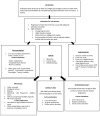Current concepts in the management of childhood myopia
- PMID: 35918919
- PMCID: PMC9672783
- DOI: 10.4103/ijo.IJO_2098_21
Current concepts in the management of childhood myopia
Abstract
Myopia or short-sightedness is an emerging pandemic affecting more than 50% population in South-Asian countries. It is associated with several sight-threatening complications, such as retinal detachment and choroidal neovascularization, leading to an increased burden of visual impairment and blindness. The pathophysiology of myopia involves a complex interplay of numerous environmental and genetic factors leading to progressive axial elongation. Environmental factors such as decreased outdoor activity, reduced exposure to ambient light, strenuous near work, and role of family history of myopia have been implicated with increased prevalence of this refractive error. While multiple clinical trials have been undertaken to devise appropriate treatment strategies and target the modifiable risk factors, there is no single treatment modality with ideal results; therefore, formulating a comprehensive approach is required to control the myopia epidemic. This review article summarizes the epidemiology, dynamic concepts of pathophysiology, and evolution of the treatment modalities for myopia such as pharmacological (atropine and other agents) and optical methods (spectacles, contact lenses, and orthokeratology).
Keywords: Atropine; childhood myopia; contact lenses; orthokeratology; refractive error; spectacles.
Conflict of interest statement
None
Figures
Comment in
-
Commentary: Curbing myopia progression: The way forward.Indian J Ophthalmol. 2022 Aug;70(8):2816-2817. doi: 10.4103/ijo.IJO_706_22. Indian J Ophthalmol. 2022. PMID: 35918920 Free PMC article. No abstract available.
Similar articles
-
A Review of Current Concepts of the Etiology and Treatment of Myopia.Eye Contact Lens. 2018 Jul;44(4):231-247. doi: 10.1097/ICL.0000000000000499. Eye Contact Lens. 2018. PMID: 29901472 Free PMC article. Review.
-
Interventions to slow progression of myopia in children.Cochrane Database Syst Rev. 2020 Jan 13;1(1):CD004916. doi: 10.1002/14651858.CD004916.pub4. Cochrane Database Syst Rev. 2020. PMID: 31930781 Free PMC article.
-
Controlling Progression of Myopia: Optical and Pharmaceutical Strategies.Asia Pac J Ophthalmol (Phila). 2018 Nov-Dec;7(6):405-414. doi: 10.22608/APO.2018333. Epub 2018 Oct 19. Asia Pac J Ophthalmol (Phila). 2018. PMID: 30338677 Review.
-
Epidemiology of Myopia.Asia Pac J Ophthalmol (Phila). 2016 Nov/Dec;5(6):386-393. doi: 10.1097/APO.0000000000000236. Asia Pac J Ophthalmol (Phila). 2016. PMID: 27898441 Review.
-
Epidemiology of myopia and prevention of myopia progression in children in East Asia: a review.Hong Kong Med J. 2018 Dec;24(6):602-609. doi: 10.12809/hkmj187513. Epub 2018 Dec 3. Hong Kong Med J. 2018. PMID: 30530867 Review.
Cited by
-
Development and validation of a model for predicting myopia in young children in China.BMC Ophthalmol. 2025 Jul 31;25(1):439. doi: 10.1186/s12886-025-04267-6. BMC Ophthalmol. 2025. PMID: 40745285 Free PMC article.
-
Relationship between dry eye disease and myopia: A systematic review and meta-analysis.Heliyon. 2024 Sep 28;10(19):e38674. doi: 10.1016/j.heliyon.2024.e38674. eCollection 2024 Oct 15. Heliyon. 2024. PMID: 39403500 Free PMC article.
-
Identifying and Exploring the Impact Factors for Intraocular Pressure Prediction in Myopic Children with Atropine Control Utilizing Multivariate Adaptive Regression Splines.J Pers Med. 2024 Jan 22;14(1):125. doi: 10.3390/jpm14010125. J Pers Med. 2024. PMID: 38276247 Free PMC article.
-
Atropine (0.05%) for rapid progressive childhood myopia (ARM study).Indian J Ophthalmol. 2025 Mar 1;73(3):358-361. doi: 10.4103/IJO.IJO_1526_24. Epub 2024 Dec 27. Indian J Ophthalmol. 2025. PMID: 39728597 Free PMC article. Clinical Trial.
-
Effects of orthokeratology on corneal reshaping and the delaying of axial eye growth in children.Heliyon. 2024 Jun 20;10(12):e33341. doi: 10.1016/j.heliyon.2024.e33341. eCollection 2024 Jun 30. Heliyon. 2024. PMID: 39022009 Free PMC article.
References
-
- Holden BA, Fricke TR, Wilson DA, Jong M, Naidoo KS, Sankaridurg P, et al. Global prevalence of myopia and high myopia and temporal trends from 2000 through 2050. Ophthalmology. 2016;123:1036–42. - PubMed
-
- Mutti DO. Hereditary and environmental contributions to emmetropization and myopia. Optom Vis Sci. 2010;87:255–9. - PubMed
-
- Naidoo KS, Leasher J, Bourne RR, Flaxman SR, Jonas JB, Keeffe J, et al. Global vision impairment and blindness due to uncorrected refractive error, 1990-2010. Optom Vis Sci Off Publ Am Acad Optom. 2016;93:227–34. - PubMed
-
- Bourne RR, Stevens GA, White RA, Smith JL, Flaxman SR, Price H, et al. Causes of vision loss worldwide, 1990-2010:A systematic analysis. Lancet Glob Health. 2013;1:e339–49. - PubMed
Publication types
MeSH terms
Substances
LinkOut - more resources
Full Text Sources
Medical


